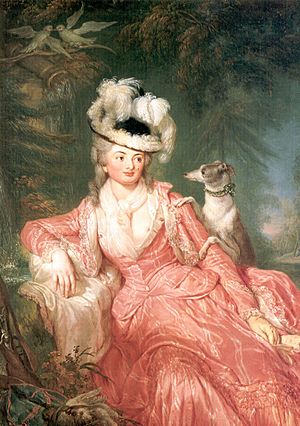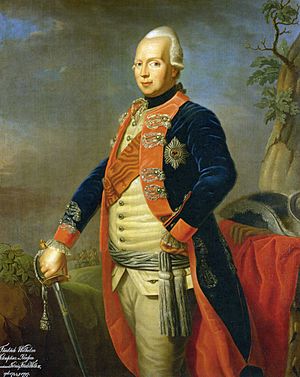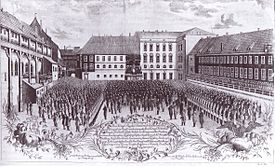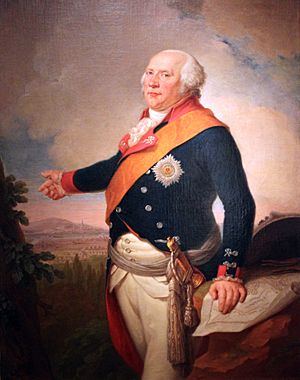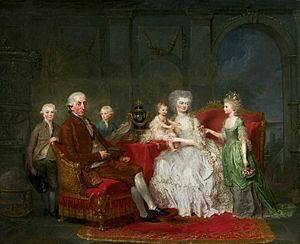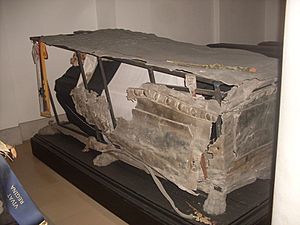Frederick William II of Prussia facts for kids
Quick facts for kids Frederick William II |
|
|---|---|
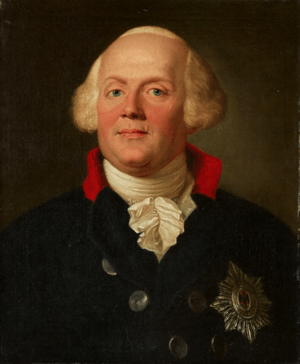
Portrait by Anton Graff
|
|
| King of Prussia Elector of Brandenburg |
|
| Reign | 17 August 1786 – 16 November 1797 |
| Predecessor | Frederick II |
| Successor | Frederick William III |
| Born | 25 September 1744 Stadtschloss, Berlin, Prussia |
| Died | 16 November 1797 (aged 53) Marmorpalais, Potsdam, Prussia |
| Burial | Berliner Dom |
| Spouse |
Elisabeth Christine of Brunswick-Lüneburg
(m. 1765; div. 1769)Frederica Louisa of Hesse-Darmstadt
(m. 1769)Julie von Voß (morganatic)
(m. 1787; died 1789)Sophie von Dönhoff (morganatic)
(m. 1790; separated 1792) |
| Issue | Princess Frederica Charlotte, Duchess of York and Albany Frederick William III of Prussia Prince Louis Charles Wilhelmine, Queen of the Netherlands Augusta, Electress of Hesse Prince Henry Prince Wilhelm Gustav Adolf Wilhelm von Ingenheim (illegitimate) Friedrich Wilhelm, Count Brandenburg (illegitimate) |
| House | Hohenzollern |
| Father | Prince Augustus William of Prussia |
| Mother | Duchess Luise of Brunswick-Wolfenbüttel |
| Religion | Calvinist |
| Signature | |
Frederick William II (born 25 September 1744 – died 16 November 1797) was the King of Prussia from 1786 until his death. He was also the Prince-elector of Brandenburg. He was known for enjoying life and being a bit lazy. Many people saw him as the opposite of his uncle, Frederick the Great.
During his time as king, Prussia faced some challenges. The country became weaker both inside and outside its borders. He also struggled to handle the big changes happening because of the French Revolution. Frederick William II tried to bring back traditional Protestantism and was against the ideas of the Enlightenment. However, he was a big supporter of the arts. He helped build famous places like the Brandenburg Gate in Berlin.
Contents
Early Life and Family
Frederick William was born in Berlin. His father was Prince Augustus William of Prussia. His mother was Duchess Luise of Brunswick-Wolfenbüttel. His aunt, Elisabeth, was married to his uncle, King Frederick II.
Frederick William became the next in line to the throne in 1758. This happened after his father died, as Frederick II had no children. He was a relaxed and fun-loving person. He didn't like to work too hard and enjoyed life's pleasures.
He married Elisabeth Christine of Brunswick-Wolfenbüttel, Crown Princess of Prussia in 1765. This marriage ended in 1769. He then married Frederica Louisa of Hesse-Darmstadt in 1769. He had seven children with his second wife. He also had other children from different relationships.
Frederick William was quite handsome when he was younger. He also had a good mind and loved the arts. Famous musicians like Boccherini, Mozart, and a young Beethoven received his support. His private orchestra was famous across Europe. He was also a talented cellist.
However, being an artist wasn't quite what Prussia needed in a king. Especially with the French Revolution about to begin. Frederick the Great had doubts about his nephew's character. Frederick William felt his uncle didn't take him seriously. He had not been properly taught about diplomacy or how to rule.
Time as King
When Frederick William became king on 17 August 1786, he made many changes. He tried to make life easier for the people. He changed the old tax system and lowered customs fees. He also built new roads and canals to help trade. These changes made him very popular with ordinary people.
Educated people were happy because he preferred the German language over French. He also welcomed German writers into the Prussian Academy of Arts. Schools and universities received more support. He also ended state monopolies on coffee, tobacco, and sugar. During his rule, a new set of laws for Prussia was finished in 1794. This law project had started under Frederick II.
Religious Policies
Frederick William II was interested in mysticism. He joined a group called the Rosicrucians in 1781. He was influenced by two men, Johann Christoph von Wöllner and Johann Rudolf von Bischoffswerder. Wöllner became a powerful advisor, almost like a prime minister. He helped the king make changes to the economy and taxes.
In 1788, a religious law was passed. It told Evangelical ministers to stick to their official teachings. It also said that Christian religion needed protection from "enlighteners." Schools were put under the watch of traditional religious leaders. A new censorship law was also made to control what books were published. This meant some major journals had to publish outside Prussia. People like Immanuel Kant were not allowed to speak publicly about religion.
In 1791, a group was set up to oversee church and school appointments. Even though many people didn't like Wöllner's religious law, it helped keep peace in Prussia. It protected the rights of different religious groups. This included Jews, Mennonites, and Herrnhut brethren. This was important because Prussia had many different Christian groups, like Calvinists and Lutherans, and also Catholics.
The king was very keen to make Prussia a strong Christian state. He even thought Wöllner wasn't doing enough. He continued to make rules to keep "true and active Christianity" alive in his lands.
Foreign Affairs
Frederick William II's approach to the army and foreign policy caused problems for Prussia. The army was very important to Prussia's strength. Previous kings had always focused on it. But Frederick William II didn't enjoy military matters. He left army decisions to a group of generals. This was the start of problems that led to a big defeat in 1806 at the Battle of Jena. Even though the army grew to its largest size under him, its training quality went down. Prussia also got into a lot of debt.
His actions in Europe didn't help Prussia much. A military action in the Netherlands in 1787 was successful. But Prussia didn't even get back the money it spent. An attempt to get involved in a war between Russia and Austria against the Ottoman Empire also failed. Prussia didn't gain any land.
The French Revolution worried the kings of Europe. In 1791, Frederick William agreed with Emperor Leopold II to support the King of France. But Frederick William didn't have enough money. His attention was also drawn to problems in Poland. Poland seemed to offer more gains than fighting France.
Prussia signed a treaty with Great Britain and the Netherlands in 1794. This gave Prussia money, but it had to provide many soldiers. However, an uprising in Poland and threats from Russia led Frederick William to make a separate peace with France in 1795. Other countries saw this as a betrayal. Prussia became isolated. Even though Prussia gained more land after the Partitions of Poland in 1795, these new areas had few German people. This caused problems and revolts.
Personal Life and Arts
Frederick William's first marriage ended after four years. His second marriage lasted until his death. He had many children from his marriages and other relationships. Because he had so many children, people sometimes called him der Vielgeliebte ("the much loved"). They also called him der dicke Lüderjahn ("the fat scallywag").
He loved building beautiful places. He had a castle built for Wilhelmine Enke on the Pfaueninsel. Other famous buildings from his reign include the Marmorpalais in Potsdam. He also oversaw the completion of the world-famous Brandenburger Tor in Berlin.
Frederick William II died in Potsdam on 16 November 1797. His son, Frederick William III, became the next king. His son didn't like his father's lifestyle. He quickly tried to change the court's ways. Frederick William II is buried in the Berliner Dom.
Children
Frederick William II had children from his marriages:
- By his first cousin Duchess Elisabeth Christine of Brunswick-Wolfenbüttel:
- Princess Frederica Charlotte (1767-1820), who married the Duke of York and Albany. They had no children.
- By Princess Frederica Louisa of Hesse-Darmstadt:
- Frederick William III (1770–1840), who became King of Prussia. He married Duchess Louise of Mecklenburg-Strelitz and had children.
- Princess Christine (1772–1773)
- Prince Louis Charles (1773–96), who married Duchess Frederica of Mecklenburg-Strelitz and had children.
- Princess Wilhelmine (1774-1837), who became Queen of the Netherlands. She married King William I of the Netherlands and had children.
- Princess Augusta (1780–1841), who married William II, Elector of Hesse, and had children.
- Prince Henry (1781–1846)
- Prince William (1783–1851), who married Princess Maria Anna of Hesse-Homburg and had children.
Images for kids
See also
 In Spanish: Federico Guillermo II de Prusia para niños
In Spanish: Federico Guillermo II de Prusia para niños


